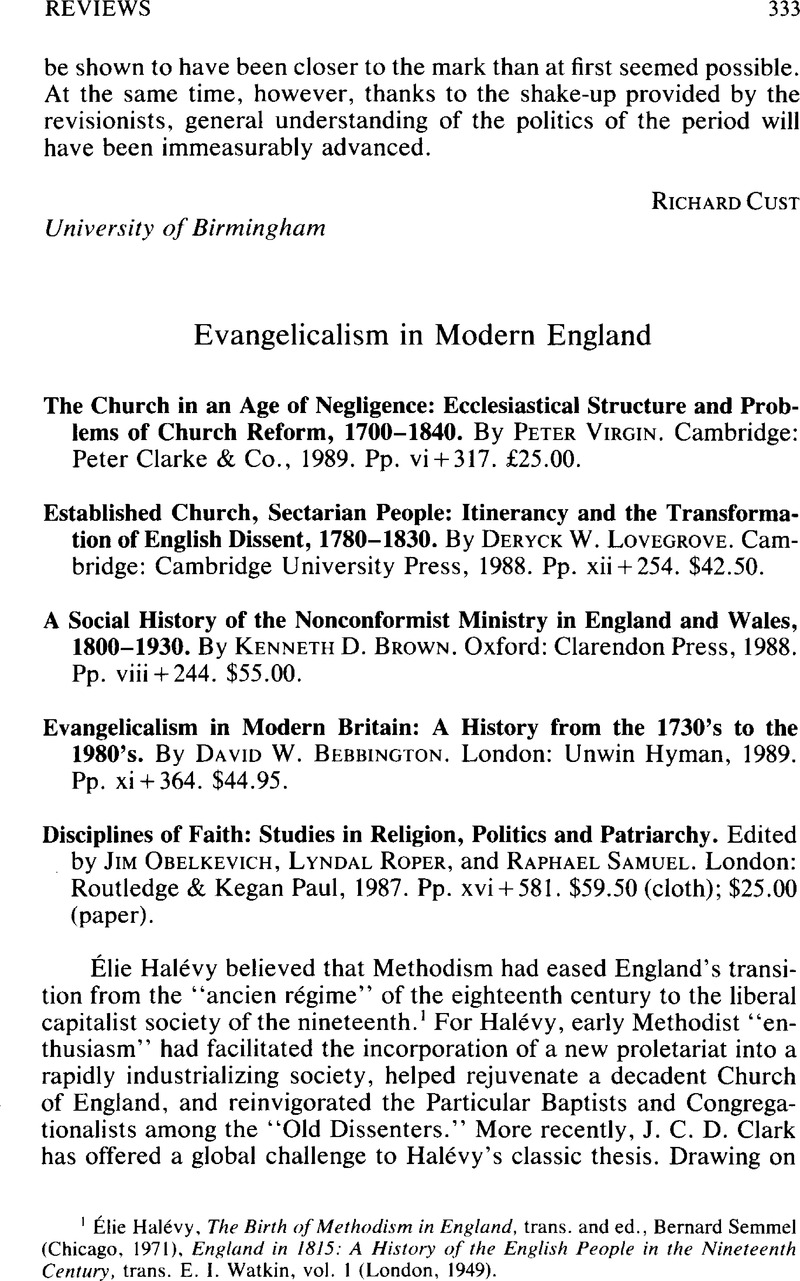No CrossRef data available.
Published online by Cambridge University Press: 10 January 2014

1 Halévy, Élie, The Birth of Methodism in England, trans. and ed., Semmel, Bernard (Chicago, 1971)Google Scholar, England in 1815: A History of the English People in the Nineteenth Century, trans. Watkin, E. I., vol. 1 (London, 1949)Google Scholar.
2 See Crafts, N. F. R., British Economic Growth during the Industrial Revolution (Oxford, 1985)Google Scholar, for a synthesis of the revisionist literature on British industrialization; and Clark, J. C. D., English Society, 1688–1832: Ideology, Social Structure and Political Practice during the Ancien Regime (Cambridge, 1985)Google Scholar, “England's Ancien Regime as a Confessional State,” Albion 21, no. 3 (Fall 1989): 450–74CrossRefGoogle Scholar. For recent qualifications of aspects of the Halevy thesis, see Walsh, John, “Élie Halévy and the Birth of Methodism,” Transactions of the Royal Historical Society, 5th ser., 25 (1975): 11–20CrossRefGoogle Scholar, “Origins of the Evangelical Revival,” in Essays in Modern Church History, ed. Bennett, G. V. and Walsh, J. D., (London, 1966), pp. 138 ffGoogle Scholar; Obelkevich, James, Religion and Rural Society; South Lindsey, 1825–1875 (Oxford, 1976)Google Scholar; Valenze, Deborah, Prophetic Sons and Daughters: Female Preaching and Popular Religion in Industrial England (Princeton, N.J., 1985)Google Scholar.
3 See, e.g., Gilbert, Alan D., Religion and Society in Industrial England: Church, Chapel and Social Change, 1740–1914 (London, 1977)Google Scholar.
4 Hill, Christopher, Economic Problems of the Church, from Archbishop Whitgift to the Long Parliament (Oxford, 1963)Google Scholar.
5 Compare Urdank, Albion M., Religion and Society in a Cotswold Vale: Nailsworth, Gloucestershire, 1780–1865 (Berkeley, 1990)Google Scholar.
6 See Urdank, chaps. 2–4.
7 Compare Valenze, who also relied heavily on obituary accounts for her study of female preachers.
8 See Teitlebaum, Michael S., The British Fertility Decline: Demographic Transition in the Crucible of the Industrial Revolution (Princeton, N.J., 1984)CrossRefGoogle Scholar.
9 See Hobsbawm, E. J., “Artisan or Labour Aristocrat,” Economic History Review, 2d ser., 37, no. 1 (February 1984): 355–71CrossRefGoogle Scholar.
10 Compare Jaffe, J. A., “The ‘Chiliasm of Despair’ Reconsidered: Revivalism and Working Class Agitation in County Durham,” Journal of British Studies 28, no. 1 (January 1989): 23–42CrossRefGoogle Scholar.
11 Thompson, F. M. L., The Rise of Respectable Society: A Social History of Victorian Britain, 1830–1900 (London, 1988)Google Scholar. Thompson's treatment uses the term “secularization” in Halevy's more positive sense; see above text, para. 1.
12 Compare Barrow, Logie, Independent Spirits: Spiritualism and English Plebeians, 1850–1910 (London, 1986)Google Scholar; and Oppenheim, Janet, The Other World: Spiritualism and Psychical Research in England, 1850–1914 (Cambridge, 1985)Google Scholar.
13 Compare Hobsbawm, E. J., “Methodism and the Threat of Revolution in Britain,” in his Labouring Men (New York, 1964)Google Scholar, who suggested that enthusiasm could have had either a quiescent or a radicalizing effect, and Valenze (n. 2 above), who maintains that enthusiasm coincided with social radicalism but remained apolitical nonetheless.